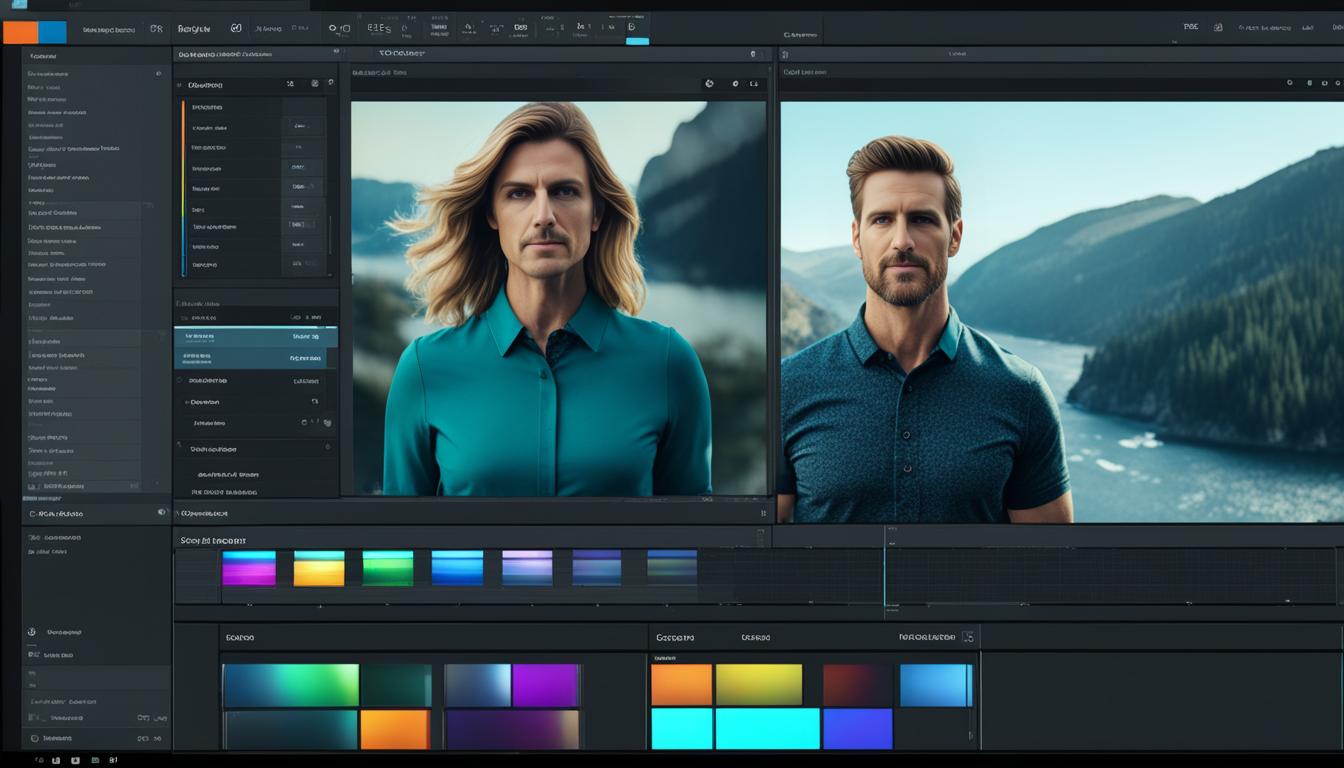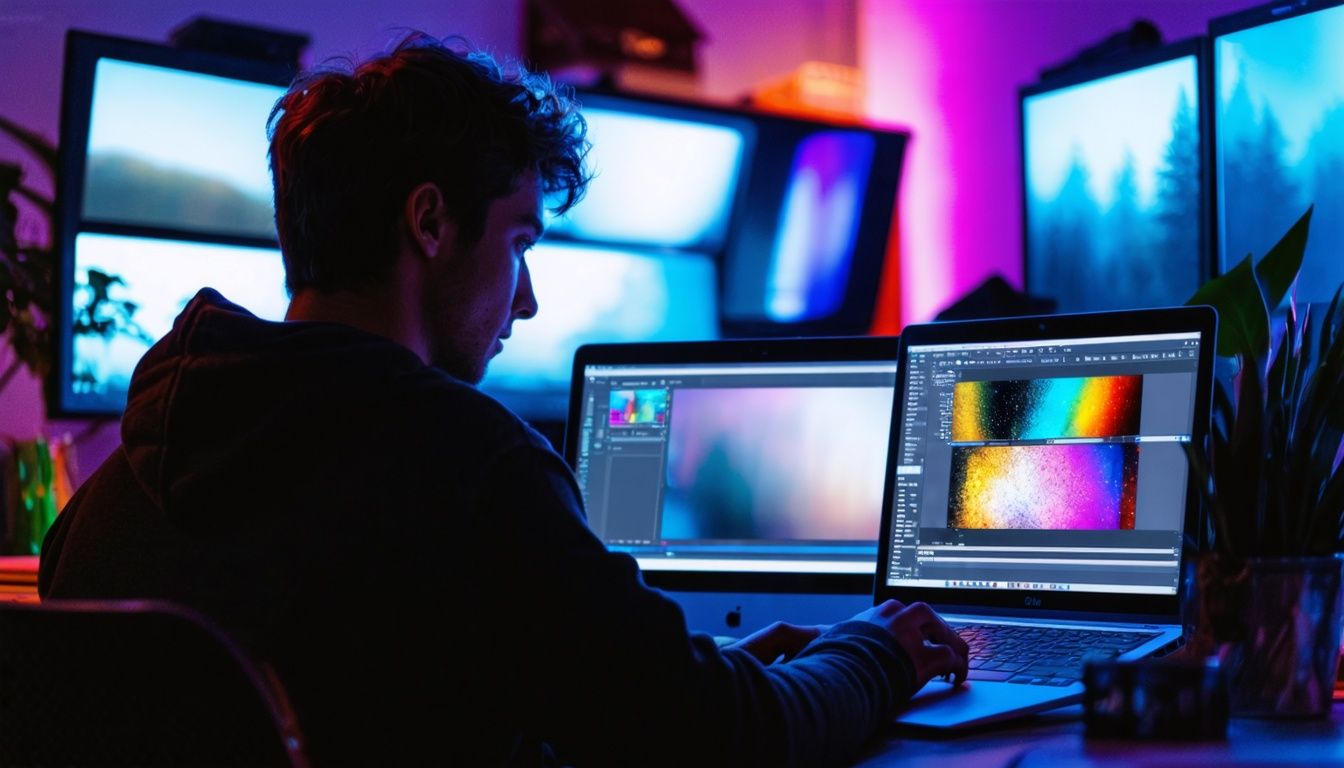Welcome to our comprehensive guide on the basics of color correction and grading! In the world of filmmaking, color grading has always been a crucial element in creating visually captivating and emotionally engaging films. From correcting color issues to manipulating the visual atmosphere, mastering color correction and grading techniques can greatly enhance the overall quality of your videos.
Color correction is the initial step in the process, where we correct any color issues in the footage, such as white balance, exposure, and brightness. Once the footage is balanced, color grading comes into play. It involves the artistic manipulation of colors, contrast, and exposure to achieve a specific look and create a visual storytelling impact.
In order to dive into the world of color correction and grading, it’s important to understand the basics of color space. Different cameras have their own optimized color spaces, and choosing the right color space for your footage can greatly impact the final image quality and colors that can be reproduced.
One powerful tool in color grading is the use of Creative LUTs (Look Up Tables). These LUTs allow you to modify the color space or visual look of an image pixel by pixel, enabling you to achieve stunning visual effects while maintaining subtlety and moderation.
Key Takeaways:
- Color correction is the initial step to correct any color issues in the footage.
- Color grading is the artistic manipulation of colors, contrast, and exposure.
- Understanding color space is crucial in achieving the desired final image quality.
- Creative LUTs are powerful tools for modifying the color space and achieving stunning visual effects.
The Importance of Color Grading in Filmmaking
Color grading plays a crucial role in the filmmaking process as it helps set the tone, mood, and atmosphere of a film. By manipulating the colors in a film, filmmakers can evoke specific emotions and enhance the storytelling experience, resulting in a more impactful and engaging movie for the audience.
Colors have a psychological impact on the audience, and through color grading, filmmakers have the power to create different moods and emotions. For example, a desaturated color grade can create a bleak and somber atmosphere, evoking feelings of sadness or reflection. On the other hand, vibrant and saturated colors can evoke excitement and energy, making the audience feel a sense of thrill or joy as they watch the film unfold.
Besides creating emotional impact, color grading also helps create a consistent and cohesive look throughout a film. It ensures that scenes flow seamlessly and enhances the visual storytelling by visually distinguishing different timelines or locations within a film. This visual distinction can make it easier for the audience to follow the story and highlight important plot points or characters.
“Color grading is an indispensable tool for filmmakers to create a specific mood, enhance the storytelling, and leave a lasting impression on the audience.”
Ultimately, color grading is an essential skill for filmmakers to master. It allows them to enhance the visual storytelling of their films, leaving a lasting impression on the audience. The psychological effects of colors, combined with the ability to create a consistent and visually distinct look, make color grading an invaluable tool in the filmmaking process.
Techniques and Tools for Color Correction and Grading
When it comes to color correction and grading, there are a variety of techniques and tools at our disposal. These techniques allow us to achieve the desired look and feel for our footage, while the tools help streamline the editing process and enhance the overall quality of our work. Let’s explore some of the key techniques and tools used in color correction and grading.
Color Correction Techniques
Color correction techniques play a vital role in establishing a neutral baseline for our footage and ensuring consistency across shots. Some essential color correction techniques include:
- Adjusting white balance: This technique helps correct any color cast present in the footage, ensuring accurate and natural color representation.
- Equalizing exposure: By equalizing the exposure levels, we can balance the brightness and contrast of the footage, enhancing its overall visual appeal.
- Reducing highlights: This technique helps control overexposed highlights, preventing them from overpowering the rest of the image.
- Increasing midtones: Increasing the midtones can add depth and richness to the image, enhancing its overall tonal range.
- Applying noise reduction: By applying noise reduction techniques, we can reduce unwanted grain or noise in the footage, resulting in a cleaner and more professional look.
Color Grading Techniques
Color grading techniques allow us to unleash our creativity and develop the desired aesthetic look for our film. Some popular color grading techniques include:
- Using curves: Curves give us precise control over the tonal range of the image, allowing us to create distinct looks and enhance visual impact.
- Applying masks: Masks enable us to selectively apply color grading adjustments to specific areas of the image, highlighting key elements or creating visual effects.
- Utilizing color wheels: Color wheels provide a comprehensive interface for adjusting the hue, saturation, and luminance of different colors in the image, giving us complete control over the color palette.
In addition to these techniques, Look Up Tables (LUTs) are a powerful tool in color grading. LUTs allow us to emulate film stocks, create specific looks, or match the color grading of different shots. They offer a wide range of creative possibilities and enhance our color grading workflow.
Color Grading Tools
When it comes to color correction and grading, having the right tools is essential. Fortunately, there are numerous color grading software and plugins available that cater to different needs and skill levels:
- DaVinci Resolve: An industry-standard color grading software that offers powerful tools and advanced features for professional color correction and grading.
- Adobe Premiere Pro: A popular video editing software that includes comprehensive color correction and grading capabilities, making it an excellent choice for filmmakers.
- Final Cut Pro: Another well-known video editing software that provides robust color grading tools and supports a seamless workflow for Mac users.
In addition to these software tools, there are various color grading plugins and presets available that can enhance our workflow and provide additional creative options. These plugins offer diverse effects, styles, and looks, allowing us to achieve unique and visually stunning results.
Color Grading Workflow
A well-structured color grading workflow is essential for efficient editing and achieving consistent and high-quality results. Here’s a general color grading workflow to guide us:
- Import the footage into the chosen color grading software.
- Perform the necessary color correction adjustments, ensuring the footage has a neutral baseline.
- Apply the desired grading techniques to develop the aesthetic look and feel of the film.
- Fine-tune the color grading and make adjustments based on the desired artistic vision.
- Preview the graded footage and make any additional refinements or corrections.
- Export the final graded footage for distribution or further post-production.
Following a systematic workflow ensures efficiency and consistency throughout the color grading process, helping us achieve our desired visual outcome.
| Software | Key Features |
|---|---|
| DaVinci Resolve | Powerful color grading tools, advanced features, industry-standard software |
| Adobe Premiere Pro | Comprehensive color correction and grading capabilities, seamless integration with other Adobe Creative Cloud applications |
| Final Cut Pro | Robust color grading tools, optimized for Mac users, intuitive user interface |

Having a thorough understanding of various techniques, utilizing the right tools, and following an organized workflow greatly contributes to our success in color correction and grading. With the right combination of technical expertise and artistic vision, we can enhance the visual storytelling of our films and captivate audiences.
Different Styles and Approaches to Color Grading
Color grading offers filmmakers the flexibility to create diverse styles and looks for their films. From evoking specific emotions to enhancing the overall cinematic experience, the choice of color grade plays a vital role in the visual storytelling process. Let’s explore some popular styles and approaches to color grading:
Cinematic Color Grading Styles
A widely acclaimed style is the cinematic color grade, which aims to create a dramatic and visually striking look using a combination of carefully selected colors and contrast. This approach often involves enhancing shadows and highlights, creating a polished and cinematic feel that captivates the audience.
Genre-Specific Color Grading
Different genres have their own distinct color palettes and grading styles that contribute to the storytelling. For instance, romantic comedies may feature lighter and brighter colors, creating a lighthearted and playful atmosphere. In contrast, sci-fi movies might utilize neons and artificial colors to convey a futuristic and otherworldly ambiance.
Teal and Orange Color Grade
A popular and frequently used color grade is the teal and orange combination. By leveraging the contrast between these complementary colors, filmmakers can achieve a visually appealing and vibrant look. The teal and orange color grade is often employed to create a sense of dynamism and enhance the overall visual impact of a film.
Monochromatic Color Grade
The monochromatic color grade emphasizes specific tones and colors, creating a visually striking and unique atmosphere. By focusing on a single dominant color, filmmakers can evoke specific emotions or establish a distinct visual style that enhances the storytelling. This approach offers a creative twist on traditional color grading techniques.
Black and White Color Grade
A timeless and classic approach to color grading is the black and white style. By removing color from the visual equation, filmmakers can emphasize contrast, texture, and composition, adding an element of elegance and emotional impact to their films. The black and white color grade can evoke a sense of nostalgia, enhance the visual storytelling, and create a timeless aesthetic.
Through varied color grading styles and approaches, filmmakers can transform their films into visual masterpieces, enhancing storytelling and captivating audiences. The choice of color grade should align with the desired mood, atmosphere, and genre of the film, allowing for limitless creative possibilities.
Conclusion
Color correction and grading are essential processes in the filmmaking journey. By understanding the basics of color correction and grading and employing various techniques, tools, and styles, filmmakers can elevate the visual storytelling of their films to new heights. These processes allow for the creation of a consistent look and atmosphere, the evocation of specific emotions, and the enhancement of the overall cinematic experience.
Color correction serves as the initial step, ensuring that any color issues within the footage are corrected. On the other hand, color grading comes after and focuses on altering colors for aesthetic reasons. The mastery of color space is crucial in achieving effective color grading, as it determines the range of colors reproduced in the final image. Choosing the right color space for your footage and deliverables is imperative.
With a wealth of knowledge, access to powerful software tools, and a strong artistic vision, filmmakers can bring their films to life and captivate audiences through the art of color correction and grading. By leveraging these processes, they can create a cohesive and visually striking visual experience that engages viewers and enhances the intended narrative.
In summary, mastering color correction and grading is essential for any filmmaker seeking to create impactful and visually stunning films. Through their expertise, they can transform raw footage into a captivating visual masterpiece, leaving a lasting impression on audiences.
FAQ
What is color grading?
Color grading is the process of manipulating raw film or video images to achieve a desired visual effect. It involves adjusting colors, contrast, and exposure to create a unified and aesthetically pleasing look for a film.
How does color grading differ from color correction?
Color correction is done first to correct any color issues in the footage, while color grading is done second to change the colors for aesthetic reasons.
Why is understanding color space important in color grading?
Color space determines the range of colors that can be reproduced in the final image. Different cameras have their own optimized color spaces, and it’s important to choose the right color space for your footage and deliverables.
What are Look Up Tables (LUTs) in color grading?
LUTs are a popular tool in color grading, allowing filmmakers to modify the color space or visual look of an image pixel by pixel.
How can color grading enhance the storytelling experience?
By manipulating the colors in a film, filmmakers can evoke specific emotions and enhance the storytelling experience. Color grading helps set the tone, mood, and atmosphere of a film.
What techniques and tools are available for color correction and grading?
Techniques for color correction include adjusting white balance, equalizing exposure, and reducing highlights. Color grading techniques involve using curves, masks, color wheels, and other precise tools. Software tools such as DaVinci Resolve, Adobe Premiere Pro, and Final Cut Pro are commonly used for color grading.
How can different styles be achieved through color grading?
Different styles can be achieved through color grading, such as cinematic color grading, genre-specific color grading, teal and orange grade, monochromatic grade, and black and white grade.
Why is color grading important in establishing consistency and visual appeal?
Color grading helps create a consistent and cohesive look throughout a film, making it visually appealing and visually distinct. It can also be used to differentiate different timelines or locations within a film.
How Can Color Correction and Grading Essentials Guide Help with Underwater Photography?
When it comes to underwater photography safety tips, color correction and grading essentials are crucial for enhancing the quality of your underwater photos. By using these techniques, you can adjust the color balance, contrast, and overall look of your images to bring out the natural beauty of the underwater world.




